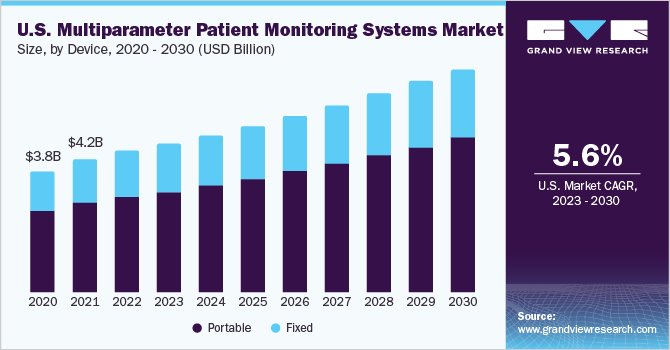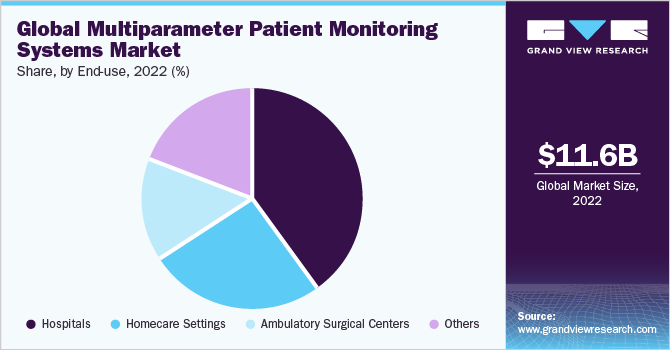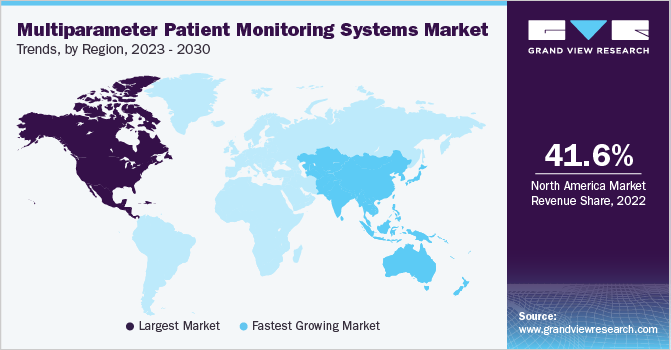- Home
- »
- Medical Devices
- »
-
Multiparameter Patient Monitoring System Market ReportGVR Report cover
![Multiparameter Patient Monitoring System Market Size, Share & Trends Report]()
Multiparameter Patient Monitoring System Market Size, Share & Trends Analysis Report By Device Type (Fixed, Portable), By Acuity Level (High, Medium, Low), By Age Group, By End-use, By Region, And Segment Forecasts, 2023 - 2030
- Report ID: GVR-4-68038-669-1
- Number of Report Pages: 116
- Format: PDF, Horizon Databook
- Historical Range: 2018 - 2021
- Forecast Period: 2023 - 2030
- Industry: Healthcare
Report Overview
The global multiparameter patient monitoring system market size was valued at USD 11.56 billion in 2022 and is expected to grow at a compound annual growth rate (CAGR) of 5.7% from 2023 to 2030. The market growth is primarily driven by the increasing demand for early diagnosis and treatment of chronic illnesses, the growing need for real-time patient monitors in critical care units, utilizing data points for enhanced clinical decisions, and providing hospital-like care in home care settings. The growth trajectory faced a few obstacles during the covid-19 pandemic. According to the CDC, in March 2020, regulators & health authorities ordered all private clinics and ambulatory care centers to stop screening patients, except for emergency procedures, resulting in high revenue loss across the health sector. Despite such obstacles, the COVID-19 epidemic has had a positive effect on the multiparameter monitoring devices industry.

During the pandemic, the monitoring of oxygen saturation and respiration rate remained key to determining the impact on lung tissue. Some studies had advised that post-COVID-19 infection, some patients may suffer from heart disorders across all regions, and remote multiparameter patient monitoring was advised as the most favorable option to evaluate and treat patients.
Inpatient wards and intensive care units (ICU) both use multiparameter patient monitors to improve the patient's quality of life. Multiparameter monitoring is an essential part of critically ill patients, especially in emergency departments as the functional response to critical sickness is linked strongly to the outcome. The monitoring of critically ill patients using multiparameter monitors allows the measurements of physiological reserves and indicates the effectiveness of therapeutic interventions. According to the Emergency Center, an estimated 136 million patients visit the emergency room each year in the U.S.
The introduction of wireless networks such as radio frequency identification (RFID) and medical body area networks (MBAN) in the healthcare sector has revolutionized the diagnostic processes of patient health without causing any discomfort attributed to its wireless design. This generally aids in monitoring heart rate, blood pressure, body temperature, and oxygen level in the body. Moreover, key strategic development undertaken by multiparameter patient monitoring participants will continue to propel growth. For instance, in June 2023, Royal Philips and Masimo announced FDA approval to integrate SedLine brain functioning monitoring, regional oximetry, and CO2 measurements with IntelliVue MX750 and MX850. The integration will allow the clinicians to assess blood saturation of the brain, anesthetic sedation, and other key factors within the same monitor.
The advancement in wearable devices and wireless communication technology for medical telemetry have further increased the scope of multiparameter monitoring solutions for patients inside and outside hospital premises. Such technological advancements enable recording and transmitting data instantly from a patient’s device to a healthcare professional, thereby decreasing the duration of evaluation and treatment. For instance, in December 2022, Shenzhen Mindray Bio-Medical Electronics Co., Ltd. launched mWear to provide six key vital patient vitals and integrate hospital-based care at home.
Device Type Insights
The portable segment dominated the revenue share in 2022 and accounted for 66.2% of the total market, and the segment is also expected to grow the fastest CAGR of 6.2% over the forecast period. This can be attributed to various advantages offered by portable systems, such as they are lightweight for easy transportation. In addition, they come in a wearable form that offers greater mobility to patients and can be used in any environment, including homecare settings. They offer vital benefits to healthcare facilities; cancer centers, hospitals, and other healthcare facilities are seeking ways to increase their reach & provide better care to patients.
Portable multiparameter patient monitoring systems offer easy mobility across different departments within and outside the hospital. The portable systems or devices are technologically advanced lightweight products that incorporate digital technology and the ubiquity of smartphones with wireless connectivity and cloud integration.
Acuity Level Insights
The high acuity multiparameter patient monitoring systems segment dominated the market with a revenue share of over 45.7% in 2022. This can be attributed to the high cost of these systems, the ability to store patient data, along with advanced connectivity options. Furthermore, high-acuity patients include those with acute life-threatening conditions and the need for continuous monitoring with cautious treatment. These patients are often admitted to critical care units such as ICUs, neonatal care units NCUs, and cardiac care units CCUs.
The low acuity multiparameter patient monitoring systems segment is expected to witness the fastest CAGR of 6.1% over the forecast period. Low-acuity patients have relatively stable medical conditions and require minimal monitoring and medical interventions. Moreover, the growing number of minimally invasive surgeries (MIS) across the world is expected to provide marketable opportunities. For instance, an estimated 18% of ambulatory MIS were performed in the U.S. in 2018, which was higher than in 2017.
Age Group Insights
Based on the age group, the market is segmented into pediatric, adult, and geriatric. The geriatric segment accounted for the highest revenue share of 53.9% in 2022, and the segment is also expected to grow the fastest CAGR of 6.0% over the forecast period. The dominant share is owing to higher chronic disease prevalence in the elderly, which requires continuous patient monitoring.
For instance, there is a high prevalence of heart disease in elderly patients due to diabetes. As per the National Council of Aging (NCOA), around 85% of the geriatric population has at least one chronic disease and 60% have at least two. Diabetes affects around 15.9 million people aged 60 years or older in the U.S. Furthermore, 7.5 million geriatric people experience mental disorders, such as dementia, anxiety disorder, or depression. The number is anticipated to reach 15 million by 2030.
End-use Insights
Based on end-use, the market is segmented into hospitals, homecare settings, ambulatory surgical centers, and others. The others involve clinics, diagnostic centers, and academic research institutes. The hospitals segment held the largest share of 40.3% in 2022. This is attributed to the increasing number of patients being admitted to hospitals due to chronic diseases, injuries, and other emergencies. Multiparameter patient monitors are widely used in general wards & ICUs, and to continuously monitor patients’ health based on various human vital parameters such as oxygen saturation, respiration rate, blood pressure, and heart rate.

The homecare settingssegment is expected to witness the fastest CAGR of 6.9% over the forecast period. Multiparameter patient monitoring systems also assist with medication management in a homecare setting. Furthermore, secure communication channels, allow patients to interact with healthcare providers. For instance, in August 2022, Medtronic entered into a partnership with BioIntelliSense, Inc. to distribute multi-parameter wearables for patient monitoring applications in hospital and home-care settings.
Regional Insights
North America dominated the global market and accounted for 41.6% of the total share in 2022 owing to the higher healthcare expenditure, growing initiatives to offer advanced patient monitoring products, and private-public partnerships. In addition, the rise in the prevalence of chronic diseases and the launch of supportive reimbursement programs are vital factors governing the growth of the market in this region.

Asia Pacific region is expected to witness the fastest CAGR of 6.4% over the forecast period. The growing aging population, increasing chronic disease burden, advancement in healthcare infrastructure, and healthcare digitization are anticipated to fuel regional market growth. For instance, more than 300 million people in China have chronic diseases. Additionally, China is the leading producer of low-cost electronic chips and products. Hence, it is projected to attract investors in China, thereby contributing to market growth.
Key Companies & Market Share Insights
The market is highly competitive, with a large number of manufacturers, the market players are focusing on various strategic initiatives such as new product launches, geographical expansion, mergers and acquisitions, collaboration, and partnerships. For instance, in June 2023, Masimo announced that it has received FDA clearance for its Radius VSM, a multi-parameter vital sign wearable. Some prominent players in the global multiparameter patient monitoring system market include:
-
SternMed GmbH
-
Spacelabs Healthcare
-
Koninklijke Philips N.V.
-
ICU Medical, Inc.
-
GE Healthcare
-
Drägerwerk AG & Co. KGaA
-
Medtronic
-
MASIMO CORPORATION
-
Skanray Technologies
-
Schiller
-
Shenzhen Mindray Bio-Medical Electronics Co., Ltd.
Multiparameter Patient Monitoring System Market Report Scope
Report Attribute
Details
Market size value in 2023
USD 12.21 billion
Revenue forecast in 2030
USD 18.03 billion
Growth rate
CAGR of 5.7% from 2023 to 2030
Base year for estimation
2022
Historical data
2018 - 2021
Forecast period
2023 - 2030
Report updated
June 2023
Quantitative units
Revenue in USD billion, CAGR from 2023 to 2030
Report coverage
Revenue forecast, company ranking, competitive landscape, growth factors, trends
Segments covered
Device, acuity level, age group, end-use, region
Regional scope
North America; Europe; Asia Pacific; Latin America; MEA
Country scope
U.S.; Canada; Germany; U.K.; France; Italy; Spain; Norway; Denmark; Sweden; China; Japan; India; Australia; Thailand; South Korea; Brazil; Mexico; Argentina; South Africa; Saudi Arabia; UAE; Kuwait
Key companies profiled
Koninklijke Philips N.V.; GE Healthcare; Shenzhen Mindray Bio-Medical Electronics Co., Ltd.; Drägerwerk AG & Co. KGaA; Medtronic; Masimo; Skanray Technologies; SCHILLER; Spacelabs Healthcare; ICU Medical, Inc., SternMed GmbH
Customization scope
Free report customization (equivalent up to 8 analysts’ working days) with purchase. Addition or alteration to country, regional & segment scope.
Pricing and purchase options
Avail customized purchase options to meet your exact research needs. Explore purchase options
Global Multiparameter Patient Monitoring System Market Report Segmentation
This report forecasts revenue growth at global, regional, and country levels and provides an analysis of the latest industry trends in each of the sub-segments from 2018 to 2030. For the purpose of this study, Grand View Research has segmented the global multiparameter patient monitoring system market report based on device, acuity level, age group, end-use, and region:
-
Device Outlook (Revenue, USD Billion, 2018 - 2030)
-
Portable
-
Fixed
-
-
Acuity Level Outlook (Revenue, USD Billion, 2018 - 2030)
-
High
-
Medium
-
Low
-
-
Age Group Outlook (Revenue, USD Billion, 2018 - 2030)
-
Pediatric
-
Adult
-
Geriatric
-
-
End-Use Outlook (Revenue, USD Billion, 2018 - 2030)
-
Hospitals
-
Homecare Settings
-
Ambulatory Surgical Centers
-
Others
-
-
Regional Outlook (Revenue in USD Billion 2018 - 2030)
-
North America
-
U.S.
-
Canada
-
-
Europe
-
U.K.
-
Germany
-
France
-
Italy
-
Spain
-
Sweden
-
Norway
-
Denmark
-
-
Asia Pacific
-
China
-
Japan
-
India
-
Australia
-
Thailand
-
South Korea
-
-
Latin America
-
Brazil
-
Mexico
-
Argentina
-
-
Middle East and Africa
-
Saudi Arabia
-
South Africa
-
UAE
-
Kuwait
-
-
Frequently Asked Questions About This Report
b. The global multiparameter patient monitoring system market size was estimated at USD 11.56 billion in 2022 and is expected to reach USD 12.21 billion in 2023.
b. The global multiparameter patient monitoring system market is expected to grow at a compound annual growth rate of 5.7% from 2022 to 2030 to reach USD 18.03 billion by 2030
b. North America dominated the multiparameter patient monitoring system market with a share of 41.2% in 2021. This is attributable to the presence of well-established players such as Masimo Corporation, Spacelabs Healthcare, Medtronic plc., and many others providing multiparameter systems.
b. Some key players operating in the multiparameter patient monitoring system market include Koninklijke Philips N.V.; GE Healthcare; Shenzhen Mindray Bio-Medical Electronics Co., Ltd.; Drägerwerk AG & Co. KGaA; Medtronic; MASIMO CORPORATION; Skanray Technologies; SCHILLER; Spacelabs Healthcare; Smiths Medical, and SternMed GmbH.
b. Key factors that are driving the market growth include high demand for real-time patient monitors in critical care units, increasing target patient population with various diseases, as well as increasing adoption of technologically advanced smart wearables with the ongoing trend of accurate and real-time monitoring.
Share this report with your colleague or friend.
![gvr icn]()
NEED A CUSTOM REPORT?
We can customize every report - free of charge - including purchasing stand-alone sections or country-level reports, as well as offer affordable discounts for start-ups & universities. Contact us now
![Certified Icon]()
We are GDPR and CCPA compliant! Your transaction & personal information is safe and secure. For more details, please read our privacy policy.
We are committed towards customer satisfaction, and quality service.
"The quality of research they have done for us has been excellent."





